
Kawanabe Kyōsai: the demon with a brush
By Christopher Harding
Published on 2 March 2022
Kyōsai blurred the divide between the popular and elite art of 19th-century Japan. Christopher Harding introduces the master of satirical and traditional painting as a rare collection of Kyōsai’s art comes to the RA.
Christopher Harding is Senior Lecturer in Asian History at the University of Edinburgh. His books include Japan Story: In Search of a Nation, 1850 to the Present (Allen Lane).
In 1870 Kawanabe Kyōsai enjoyed a night out so raucous that its final stop was a Tokyo jail cell. Unlike most whose evenings ended in this way, his offence was not drunkenness, violence or theft. He had painted a picture. To be sure, Kyōsai had been drunk as well, having attended a shogakai: a commercially organised party at which painters and calligraphers produced spontaneous creations, and which were not known for their seriousness or sobriety (Calligraphy and Painting Party (Shogakai), 1876–78; below). He could not, as a result, recall the image in question. The precise charges made against Kyōsai remain a mystery, but a rumour persisted that he had taken as his theme that evening Japanese political and commercial humiliation at the hands of predatory and entitled Westerners. One of his works was said to have employed a vivid sexual metaphor, in which case he perhaps compounded his offence of ‘insulting important people’ – and in public, no less – with the inflammation of moral sensibilities. Whatever his misdemeanour, Kyōsai was arrested on the spot.
A period of hard prison time followed, hurting Kyōsai’s health but not his reputation. Images were an important means of conveying news and views in this era, and the prizing of virtue and public conformity offered dry tinder to which an enterprising satirist might profitably hold a match. Kyōsai was among the greatest of them: a pioneering caricaturist who also produced technically brilliant paintings and illustrations. His humour and highly trained talent led him to become one of the best-loved chroniclers of Japan’s entry into the modern world. His proficiency in a range of styles, enormous output and broad-minded approach as a teacher helped to ensure that his country made that journey with as much as possible of its rich artistic inheritance intact. This spring, art lovers in London have an unparalleled opportunity to discover his singular work, as one of the world’s foremost Kyōsai collections, privately owned by the art dealer Israel Goldman, graces the Royal Academy’s walls.
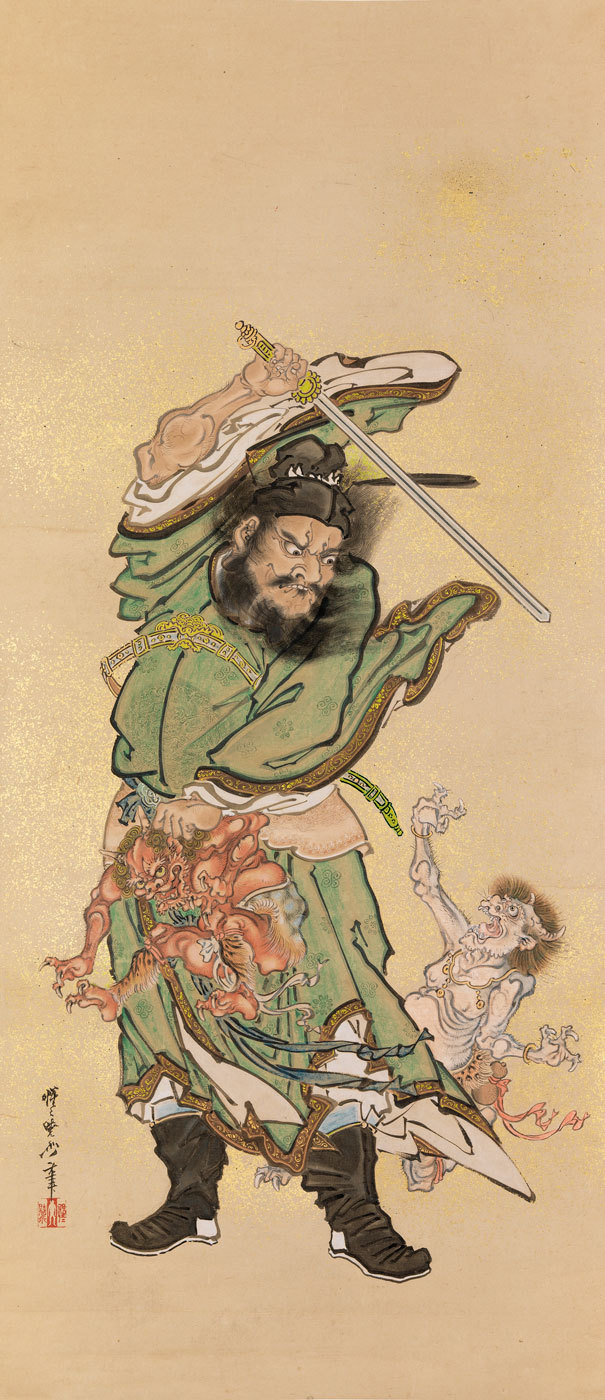
In 1870 Kawanabe Kyōsai enjoyed a night out so raucous that its final stop was a Tokyo jail cell. Unlike most... his offence was not drunkenness, violence or theft. He had painted a picture.
For someone of Kyōsai’s natural ability, born in 1831, there were probably only three places in Japan where it was worth growing up: Kyoto, Osaka and Edo. Kyoto’s landscape of shrines and temples, grand homes and gardens, testified to a thousand years of cultural pre-eminence by this point. Osaka and Edo owed their emergence to the previous 200 years of relative peace and prosperity. Back in the early 1600s, Tokugawa Ieyasu had unified the country and secured appointment from the Emperor as ‘shogun’: a military office (‘barbarianquelling generalissimo’) that made him de facto ruler of the country. Ieyasu’s administration, or ‘shogunate’, imposed on Japan a settlement that turned his headquarters in Edo into the effective capital, supported by a patchwork of semi-independent feudal domains. Serving these domains in various capacities was a highly stratified samurai class, which in turn stood above the country’s great mass of farmers and artisans. At the bottom of the social pile were merchants, regarded as lowly because they traded in the fruits of other people’s labour rather than producing anything themselves.
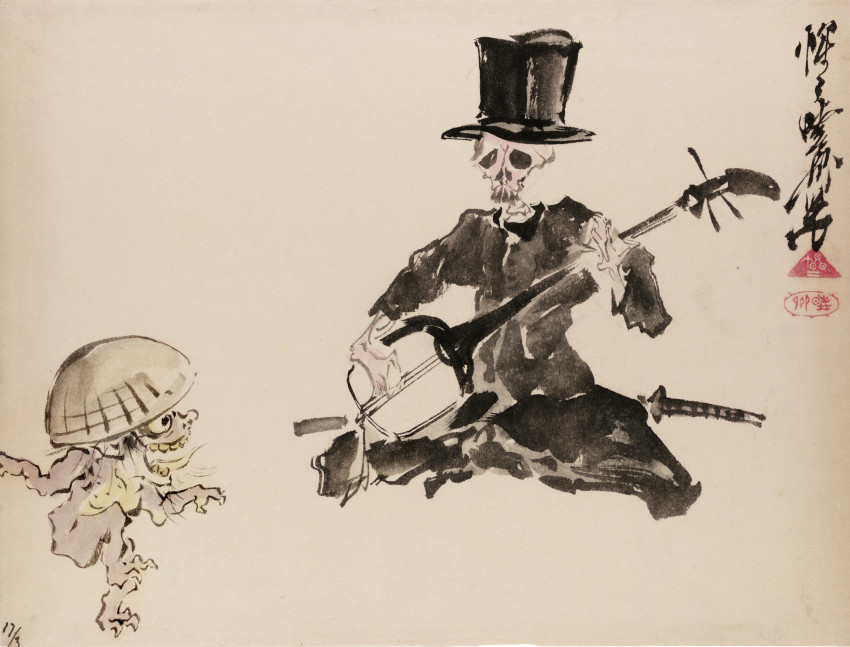
By the 1830s, this settlement was falling apart. Kyōsai’s parents would have disgusted Ieyasu: a woman of good samurai stock marrying a former rice merchant. But long years of peace had not been kind to the samurai. Their shift from warrior work to office work left many so impoverished, of pocket and reputation alike, that they became figures of fun for the artists, writers and performers who flourished in places like Osaka and Edo. Some merchants, by contrast, were wealthy enough to bankroll these thriving urban entertainments while buying into samurai culture when it suited them. Desperate members of a once-great warrior caste were persuaded to sell off swords, armour, daughters and even full samurai status. Kyōsai’s father, Kiemon, appears to have been a beneficiary, after being adopted into the samurai family of the Kawanabe, and purchasing for himself a place as an heir of the Kai family, who served as firefighters in Edo. This made Kiemon a samurai retainer of the shogunate itself.
The family moved to Edo in 1832, when Kyōsai – known at this point by his given name Shūzaburō – was just a year old. The boy soon showed such promise as an artist that at the age of six his parents entered him into the studio of Utagawa Kuniyoshi. Kyōsai’s new master was making a name for himself by this time producing woodblock prints in the ukiyo-e – ‘floating world’ – style, including great warriors from Japanese and Chinese culture drawn with ghostly or ghastly supernatural twists. Kuniyoshi imparted to Kyōsai an invaluable series of lessons in observing nature, including human movements. He counselled his young charge to strive not for straightforward representation but rather to capture ‘spirit and force’ in his painting – homing in on what happens when one person throws another to the ground: the muscle tension; the straining, bulging eyes.
He created for himself the art name ‘Kyōsai’, combining the character kyō (狂), meaning ‘comic’ or ‘parodic’, with sai (斎) meaning ‘room’ – or in this case the ‘studio’ from which creations in his favoured genre of ‘comic pictures’ (kyōga: 狂画) would emerge.
After about two years of study, Kyōsai’s family withdrew him from Kuniyoshi’s school. His father perhaps baulked at the eccentricities of Kuniyoshi’s style or at his uneasy relationship with the shogunal authorities. The final straw may have been Kyōsai’s discovery of a severed head in a river. Most children would have fled the scene in tears. Kyōsai fished it out, took it home, and started to sketch it.
Kyōsai’s parents moved him to a branch of the altogether more respectable Kano school, whose master Maemura Tōwa dubbed him the “demon of painting”. When Tōwa became too ill to continue teaching, he secured a place for Kyōsai with Kano Tōhaku, at the Surugadai branch of the school. After a ‘pre-painting’ period of around two years, during which he assisted with preparing materials in the studio, Kyōsai began the systematic study of traditional Chinese and Japanese painting. This included the meticulous and repeated copying of a prescribed series of classic subjects, such as images of Daoist immortals, Buddhist saints and Japanese legendary figures. Alongside this ran monthly connoisseurship sessions at which pupils would be challenged to identify the makers of various paintings without recourse to seals or signatures.
Despite taking time out from his training to enjoy all that Edo had to offer a young man – including drinking, rakugo storytelling, brothels, kyōgen (comic theatre) and bunraku puppet plays – Kyōsai managed to complete the Kano curriculum by 1849. Thanks to his teacher, he secured adoption into the family of Tsuboyama Tōzan, official painter for the feudal domain of Tatebayashi. In theory, this meant that he would one day accede to that role himself. It was not to be. Amid rumours of dissipation, Kyōsai cut ties with the Tsuboyama family in 1852. A few years later, he embarked on a career as an independent artist.

Kyōsai was far from alone in heading off down an unexpected path in the 1850s. For more than two centuries the shogunate’s careful management of the country’s borders had combined with a relative lack of Western interest in Japan – there were richer pickings in India, China and the ‘Spice Islands’ – to ensure a relatively quiet life for the Japanese. That was now changing. The American Commodore Matthew C. Perry arrived in Edo Bay in 1853, demanding diplomatic relations at the point of a gun – several guns, in fact, along with awesome-looking cannon and steamship technology, all of it so far in advance of anything the Japanese possessed that simple rebuff seemed out of the question.
The next 15 years saw a series of diplomatic and trade treaties signed with major world powers, including Britain, that were regarded in Japan as deeply humiliating – not least the requirement that foreigners committing crimes in newly opened ‘treaty ports’ would be tried under their own rather than Japanese jurisdiction. Outraged lower-ranking samurai began reinventing themselves as shishi: ‘men of high purpose’, intent on overthrowing a discredited shogunate and restoring the Emperor to power.
It was during this febrile decade and a half, marked by outbreaks of shishi violence against political enemies and foreigners alike, that Kyōsai married, had his first child and launched his career. He created for himself the art name ‘Kyōsai’, combining the character kyō (狂), meaning ‘comic’ or ‘parodic’, with sai (斎) meaning ‘room’ – or in this case the ‘studio’ from which creations in his favoured genre of ‘comic pictures’ (kyōga: 狂画) would emerge.
Tokugawa Japan’s strictly hierarchical social politics had long rendered satire both an irresistible temptation and a risky undertaking. The result was that Japanese writers and artists had become masters of allegory, drawing on everything from folklore to the animal kingdom to poke fun at their leaders while maintaining a degree of plausible deniability. There was an older inspiration to the mix, which Kyōsai readily embraced: the medieval monk and painter Toba Sōjō, traditionally credited with creating the Chōjū Jinbutsu Giga (Scrolls of Frolicking Animals and Humans) featuring frogs, rabbits and other animals satirising everyday human pursuits and pomposity.

One of Kyōsai’s earliest offerings in this vein was Fashionable Picture of the Great Frog Battle (1864), showing violence breaking out in a lily pond between groups of frogs armed variously with water-cannon and bulrush spears. Viewers at the time would have spotted the crests adorning the curtains of each encampment and understood immediately: a clan allied to the Tokugawa was fighting the rulers of Chōshū domain – a region of south-west Japan never entirely reconciled to Tokugawa rule, and at the forefront now of violent opposition to the ailing shogunate.
In 1868, that opposition escalated into a civil war in which forces supporting the restoration of the Emperor chased the Tokugawa and their allies northwards up Japan’s main island all the way to a final surrender on what is now the island of Hokkaidō. Edo became ‘Tokyo’ (‘Eastern Capital’) and the name ‘Meiji’ (‘Enlightened Rule’) was chosen for the reign of the newly restored Emperor. He served as the figurehead for the revolutionary change that followed, lauded in retrospect as a pioneering national overhaul – creating Asia’s first modern nation state – but at the time subject to more mixed reviews. Kyōsai was among those reviewers, marking a period of uncertainty, craving for Western affirmation, and trial and error with cultural imports (from governance and industry to food and fashion) with a series of comical, sometimes bizarre images.
In one of these works, a skeleton wearing an incongruous combination of Western-style top hat and an old samurai sword plays a three-stringed shamisen while a tiny monster dances gleefully in the foreground (1871-78; above). Another shows one of Japan’s new Western-style schools, complete with benches, desks, boards and besuited masters – except this is a ‘School for Spooks’ (bakebake gakkō) (1874; below), at which the offspring of demons and water-sprites are taught their trade. Ever in tune with popular feeling, Kyōsai may have had in mind people’s misgivings about losing child labour in the fields to institutional education (an untested privilege for which families were asked to pay) along with government attempts to extend its writ into the supernatural realm. ‘Superstitious beliefs’ were blamed for holding the country back, and were beginning to come under attack – a move that critics regarded as an assault on the Japanese imagination, not to mention the pockets of artists for whom ghosts and ghouls had long represented a rich seam.

After about two years of study, Kyōsai’s family withdrew him from [art] school... The final straw may have been Kyōsai’s discovery of a severed head in a river. Most children would have fled the scene in tears. Kyōsai fished it out, took it home, and started to sketch it.
In a world turned upside-down, an artist of Kyōsai’s mischievous genius would never be short of inspiration. But his arrest in 1870 made clear the risks that he was taking. Japan’s new leaders were low-ranking samurai, mostly unknown to the public. They had the advantage of the Emperor as their figurehead, but they were politically and economically weak nevertheless and feared further compromise to Japan’s autonomy at the hands of Western colonial powers. Casting around for the glue that might help bind the new nation together – reverence for the imperial family, a national curriculum, newly reworked ‘Japanese’ values – they feared that satire might act like solvent.
Alongside his comic work, Kyōsai continued to paint more traditional pieces. Had he stuck only with the Kano school, his work might have featured in a new artistic canon that was being pieced together at this time, comprising forms that Japan’s leaders hoped would garner international respect: ceramics, traditional painting, metalwork, religious statuary and even kabuki theatre – cleansed of its bawdy excesses and transformed into something resembling European opera. By contrast the popular art of the Edo period, and the rambunctious town life that produced it and provided subject matter, was regarded as having very little going for it anymore. Foreigners were apt to regard the Japanese as uncivilised, a little uncouth. Woodblock prints depicting fighting, farting and fantastical sexual encounters would do little to persuade them to revise that view – however much Western collectors seemed to enjoy them.
Kyōsai did receive a measure of official approval, when his Kano-style painting of a crow won top prize at the Domestic Industrial Exposition, in Tokyo in 1881. Yet the judges’ praise for the “mighty power” of his brush was qualified by the observation that this “one beauty conceals a thousand counts of ugliness” – a reference, no doubt, to Kyōsai’s contributions to the kyōga (comic picture) genre, banned from the Expo as “vulgar, capricious and idiotic”.

The divide between popular and elite art was never cut-and-dried in Japan, and Kyōsai’s talents helped to blur it further. He brought astonishing technique to even the simplest satire. And as students at his art school could attest, he was a kindly but demanding master in the traditional mould: students learned first by watching and assisting him – stretching silk, grinding ink, preparing colours. His son Kyōun and daughter Kyōsui became so proficient in learning and emulating their father’s style that their works were frequently mistaken for his.
Among Kyōsai’s foreign students in the 1880s was the British architect Josiah Conder, who had arrived in Tokyo to take up a post teaching Western architecture. The two became friends, and Kyōsai’s picture diary (enikki) shows him travelling by rickshaw to Conder’s home to teach him. It is clear from Conder’s account of Kyōsai’s teaching style (Paintings and Studies by Kawanabé Kyōsai, 1911) and from Kyōsai’s own Kyōsai gadan (Kyōsai’s Account of Painting, 1887) that his foundation remained the technical training acquired at the Kano school combined with the close, disciplined observation of the world instilled in him as a boy by Utagawa Kuniyoshi. On a sketching trip to the historic town of Kamakura, Conder observed that, for Kyōsai, “to copy once was to completely assimilate”: he could then reproduce an image time after time without ever having to refer back to his original copy and notes.

Monkey in a Tree by a River, Holding Loquats (detail: right-hand scroll of a diptych), May 1888

'School for Spooks' (Bakebake gakkō) no. 3 from the series 'Drawings for pleasure by Kyōsai' (Kyōsai' rakuga), 1874

Calligraphy and Painting Party (Shogakai), c. May 1876 – spring 1878
Kyōsai’s widely recognised mastery earned him an enormous number of commissions across his lifetime, with nearly 300 remaining unfulfilled at the time of his death. His illustrations were enjoyed by readers of books on topics as diverse as geography, history and science. And yet despite his extraordinary versatility, which included an openness to Western techniques and an expectation of future innovations that Conder found impressive in someone of his generation, Kyōsai was perhaps, in the end, wedded more to old Edo than to new Tokyo. That included the painting and calligraphy parties (shogakai) that originated in that earlier era. By the time Kyōsai was growing up they had become mass gatherings held in large restaurants: artists and calligraphers lubricated by sake, tended to by geisha and producing spontaneous pieces on the requests of paying guests. One such meeting in 1853 had become sufficiently lively that Kyōsai’s teacher, Kuniyoshi, tore off his clothes and used them as brushes when his art supplies proved inadequate for the gargantuan image of a bandit-hero on which he had embarked.
Kyōsai was one of the most sought-after guests at these gatherings, both before and after his arrest and imprisonment in 1870. Kyōsai appeared, late in life, to have developed something of a love-hate relationship with shogakai – did the old master sense, perhaps, that these events were no longer what they once had been? Nor does he seem to have enjoyed being goaded to paint by international guests at private parties. Another of his foreign admirers, Mortimer Menpes, recalled one such event in 1887, just two years before Kyōsai’s death. It took a great quantity of sake to get Kyōsai in the mood that evening. Finally he consented, approaching the silk, ink and brushes that had been prepared for him:
“He looked like a god as he knelt there, gripping his brush and staring at the silk – he was seeing his picture. He executed a flight of crows, a masterpiece… Proudly drawing himself up to his full height, quivering in every limb, he threw down his brush, skidded the silk along the floor to the spectators, and saying ‘That is Kyōsai’, left the house. Everyone… realised that a master had been among them.”
Kyōsai: The Israel Goldman Collection takes place in The Gabrielle Jungels-Winkler Galleries, Royal Academy of Arts, London, 19 March–19 June 2022.
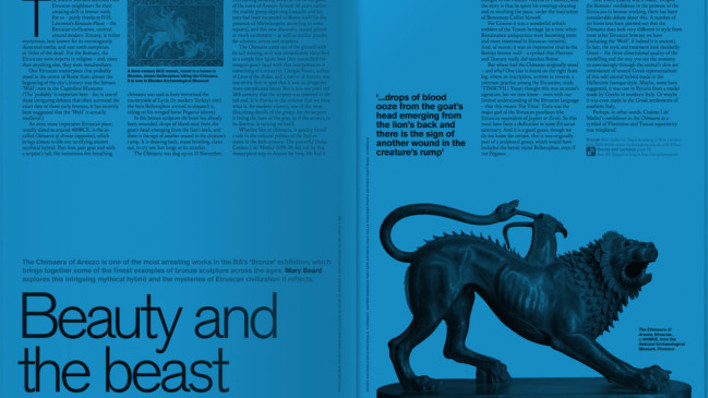
Enjoyed this article?
As well as free entry to all of our exhibitions, Friends of the RA enjoy one of Britain’s most respected art magazines, delivered directly to your door. Why not join the club?
Related articles
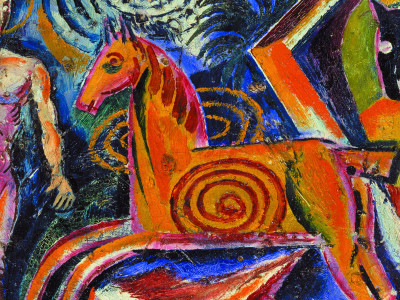
Visions from Ukraine
19 June 2024
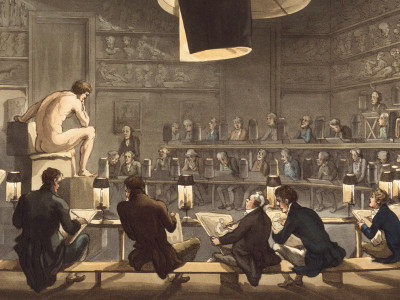
10 RA Schools stories through the centuries
16 May 2024
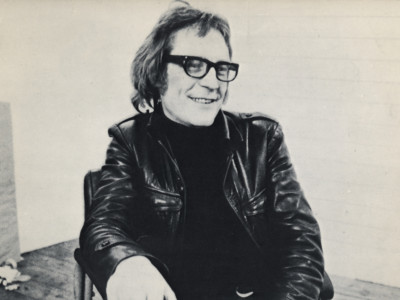
In memoriam: Mick Moon RA
1 May 2024